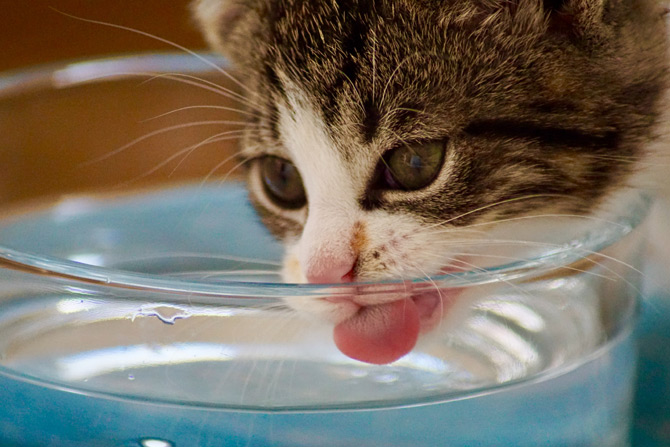Dehydration occurs when fluid levels drop below the normal amount. This might leave you wondering ‘how much water does my purring pal actually need?’ and ‘what are the signs a cat is dehydrated?’
Of course, we all know we should drink more water in summer to keep our hydration levels up, but it’s important to apply the same principle to our pets.
Without a doubt, dehydration isn’t good and can lead to serious health complications. Therefore, as a responsible pet owner, it’s essential to recognise the warning signs of dehydration in cats and how to treat it.
Causes of dehydration in cats
Before we look at the telltale signs a cat is dehydrated, let’s consider the possible causes. After all, knowing the causes might help us to prevent our cats from becoming dehydrated in the first place!
Cats’ bodies are similar to humans in that they’re made up of 80% water so, just like us, they can suffer from dehydration. Particularly during the warmer months, it’s important to be aware of the potential causes of dehydration.
The cause of dehydration in cats is either reduced water intake or increased loss of fluid. For example, a cat can lose fluid from overheating, vigorous activity or as a result of an illness that has caused vomiting or diarrhoea. Additional causes of dehydration in cats include:
- Fever
- Shock
- Blood loss
- Diabetes
- Kidney failure
- Malnutrition
Signs your cat is dehydrated
The telltale sign of dehydration in your meowing mate is often a change in their behaviour or activities. If your feline friend is usually quite active but suddenly becomes very lethargic – pay attention to this. Lethargy and reduced appetite often go hand in hand with dehydration. Other signs of dehydration in cats include:
- Sunken eyes
- Dry mouth
- Panting
- Increased heart rate
- Dry, tacky gums
- Decreased skin elasticity
Skin tenting is a simple, at-home test you can do to check on your cat’s hydration levels. Using your index finger and thumb, lightly pinch the fur at the back of your cat’s neck, right above the shoulder. Normal, hydrated skin will snap back into place once you release it. However, if the skin remains bunched up (tented) when you move your fingers away this is a sign your cat could be dehydrated.
Treatment for dehydrated cats
If you think your feline friend is dehydrated seek immediate attention from a registered veterinarian. In severe cases of dehydration, a blood test may be required to determine the health of your cat and the vet is likely to use an IV drip for instant re-hydration.
If your cat is able to drink (perhaps through a syringe or pipette) try giving him or her small amounts of water. Ensure your cat is comfortable and positioned in a cool, well-ventilated area. Some cats might like to have a cool, damp towel placed under them.
Dehydration is often the result of consistent hot weather or lack of access to fresh water. However, dehydration in cats can also be linked to several illnesses or diseases so it pays to source the advice of a vet.
How to prevent dehydration in cats
Sure, you can’t force your cat to drink water, but you can take steps to ensure your cat is less likely to become dehydrated. Here are a few tips to help keep your cat remains happy and hydrated.
- Make sure your cat has access to clean drinking water at all times, but especially during the warmer months.
- Think about placing a few extra water bowls in different areas of the home. You might even consider different types of water dispenses, which can be useful if you have a fussy cat.
- Keep your feline friend’s water bowl clean. Dirty, old water might put your cat off drinking.
- Older pets struggle more with the heat, so make sure you keep a close eye on your cat if it’s getting on in years.
- Clue up on how much water on average your cat should be drinking per day. Cats drink approximately 45-50ml per kilogram of their body weight. So, given that an average cat weighs about 4.5kg, typically a cat should be drinking 200-225ml of water per day.
- Perhaps consider including some wet food in your cat’s diet. Wet food has a higher water content than dry food, which can help increase your cat’s hydration levels.
Related posts
Image source: Unsplash.com







Leave A Comment